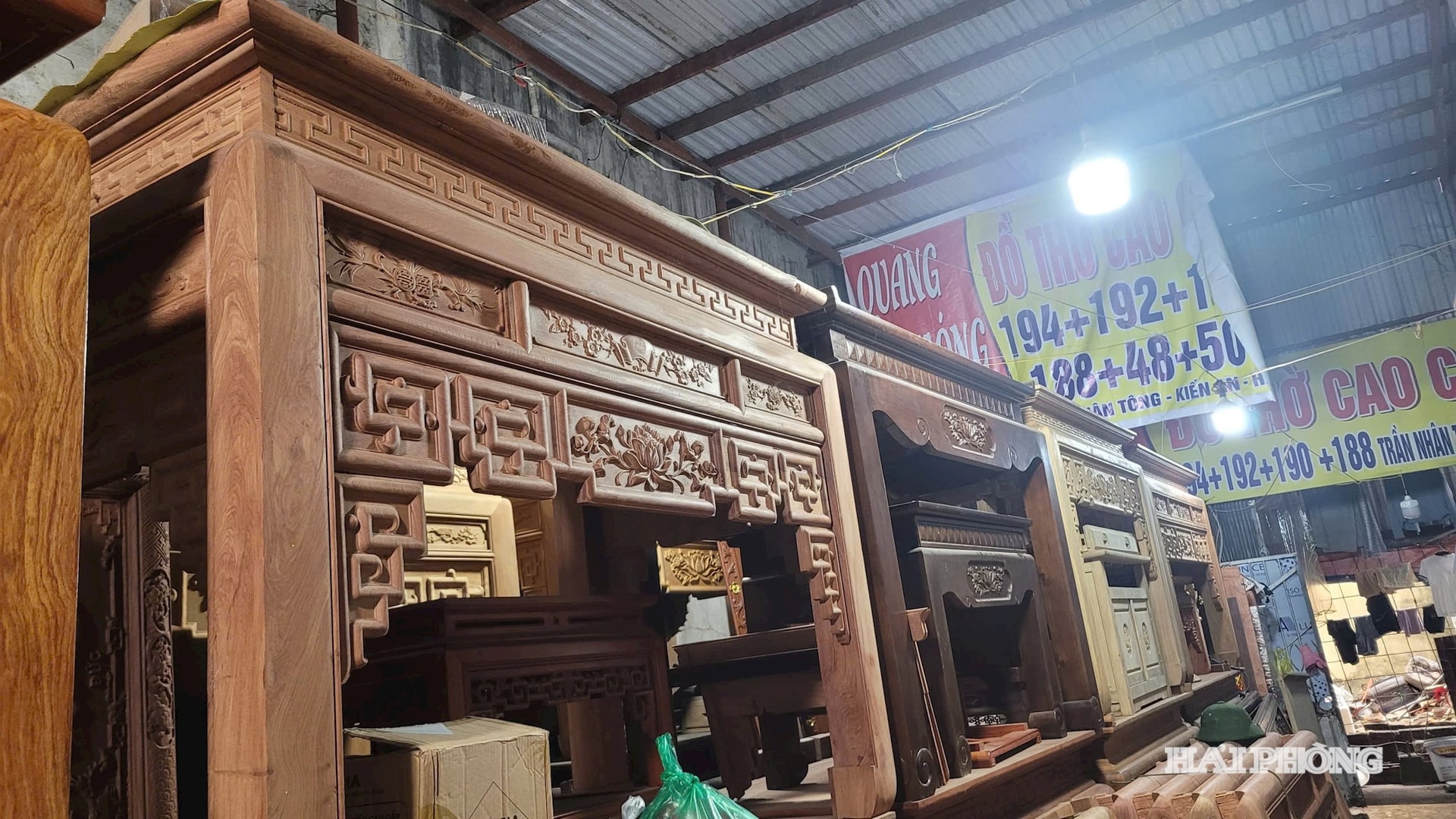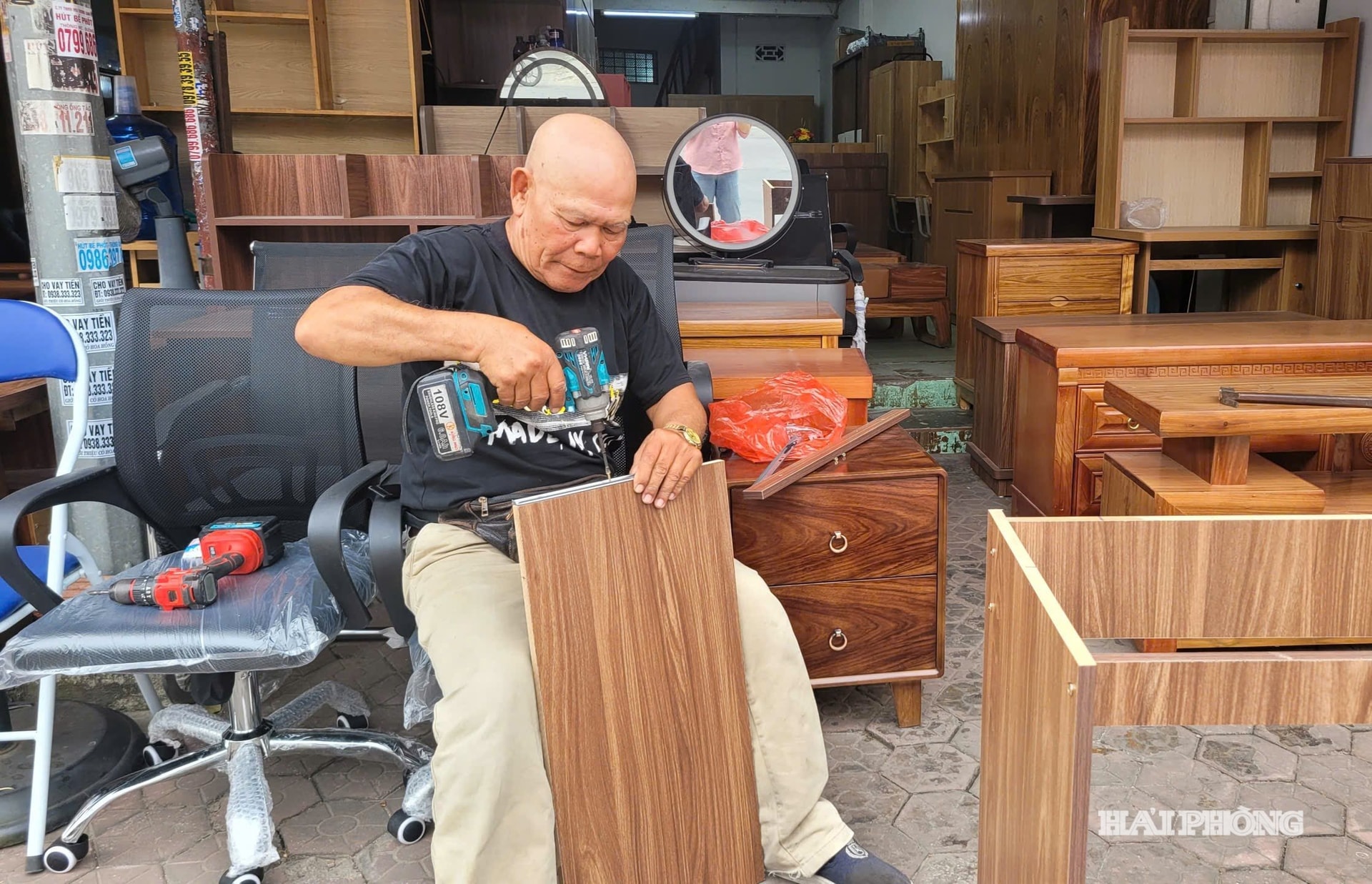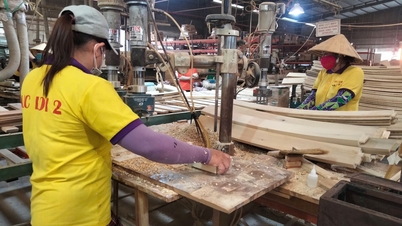
Inheriting the identity of the ancient carpentry village
“If you want to buy furniture, just go to Tran Nhan Tong street”, this familiar saying to many people in the Port City has become the “brand” of this street specializing in selling wooden furniture.
At the end of the year, when many families are busy renovating their houses, buying furniture and altars to celebrate Tet, Tran Nhan Tong Street is bustling with visitors. On both sides of the street, rows of shops stretch out side by side, displaying all kinds of products from living room tables and chairs, kitchen cabinets, beds and wardrobes, to rosewood beds, sideboards, altars, horizontal lacquered boards, parallel sentences, etc.
According to Mr. Pham Van Minh, 58 years old, owner of a furniture store for more than 20 years on Tran Nhan Tong street, in the past, on this street there were only a few houses doing carpentry, then opening small retail stores. Entering the period of renovation and opening the economy , when people's lives improved, the demand for furniture increased sharply, many households selling other products also switched to selling furniture. Now, almost every house on the street sells and has become a famous street specializing in selling wooden furniture in Hai Phong city.

What makes this street unique is the inheritance of the profession. Here, many families have up to three generations of the profession. The family of Ms. Pham Thi Hang, owner of Hang Thanh furniture store, is the third generation to do business on Tran Nhan Tong street. She shared: “My family has been in the business since my grandfather's time. Before, they only chiseled, carved, and then sold wholesale. Now, the children have opened shops, run their business systematically, and have more diverse designs. But the roots of the carpentry profession and the quintessence of the altar making profession are still preserved as they were left by their ancestors.”
According to many long-time residents here, the origin of Tran Nhan Tong furniture street began from Kha Lam carpentry village - a land famous for its sophisticated carvers. They brought their profession to the street, both producing and trading on the spot. Just like that, the profession followed the people to create a street specializing in trading wooden furniture.

Mr. Nguyen Huu Cuong, a long-time resident of this street, commented: "When talking about Tran Nhan Tong street, people immediately think of worship items, especially altars. To sell their products, carpenters must not only be good at their craft, but also understand feng shui and know about worship culture."
Indeed, when choosing an altar, customers not only look at whether the carvings are beautiful or not, but also at the size, age, destiny, etc. If the seller does not understand, he cannot advise.
Not only wooden furniture, the street also has shops selling accessories, altar decorations, feng shui items... creating a complete ecosystem for the "craft street" specializing in interior design.
According to the representative of the Economic, Infrastructure and Urban Department of Kien An Ward, Tran Nhan Tong Street is one of the earliest streets specializing in furniture trading. The entire street has hundreds of furniture trading establishments, creating stable jobs for many local workers. The Ward aims to preserve traditional crafts, combining urban beautification to both develop the economy and build the image of a civilized and modern craft street.
Challenges and new directions

Like many other specialized streets, furniture businesses on Tran Nhan Tong Street are facing many challenges. Narrow premises, high rental costs, and fierce competition from e-commerce have forced many businesses to change their business methods to adapt.
“In the past, just displaying the products beautifully was enough for customers to come. Now many people sell online, I also have to learn how to take photos, record videos , and introduce products on social networks. Selling now is not just a job, but also the art of storytelling, you have to know how to tell the story of each product,” Ms. Pham Thi Hang shared.

Not willing to be limited by the old way of doing things, many young people on Tran Nhan Tong street have boldly invested in opening their own workshops, registering trademarks and expanding into industrial wood and imported wood furniture lines. They combine traditional business with online promotion, helping to maintain the vitality of the craft street in the digital age.
Mr. Nguyen Van Phong, owner of an interior design shop on this street, said: “Customers today are very diverse. Young people focus on design and convenience, while older people are more interested in spiritual factors and wood materials. Therefore, we cooperate with architects to design altars and cabinets suitable for each apartment, both modern and maintaining traditional solemnity.”
Tran Nhan Tong Street today is not only a place for business, but also preserves the quintessence of traditional carpentry in Kien An region. The street not only provides interior products for many families, but is also a place where the skills, passion and identity of carpentry in Hai Phong city converge.
Each altar, each set of mahogany furniture, and each cabinet here contains a story about the craftsman's hands, about the worship culture, and about the traditional lifestyle of the Vietnamese people.
HAI MINHSource: https://baohaiphong.vn/mua-do-tho-den-pho-tran-nhan-tong-o-hai-phong-525652.html



![[Photo] Opening of the 14th Conference of the 13th Party Central Committee](https://vphoto.vietnam.vn/thumb/1200x675/vietnam/resource/IMAGE/2025/11/05/1762310995216_a5-bnd-5742-5255-jpg.webp)




































![[Photo] Panorama of the Patriotic Emulation Congress of Nhan Dan Newspaper for the period 2025-2030](https://vphoto.vietnam.vn/thumb/1200x675/vietnam/resource/IMAGE/2025/11/04/1762252775462_ndo_br_dhthiduayeuncbaond-6125-jpg.webp)








































































Comment (0)